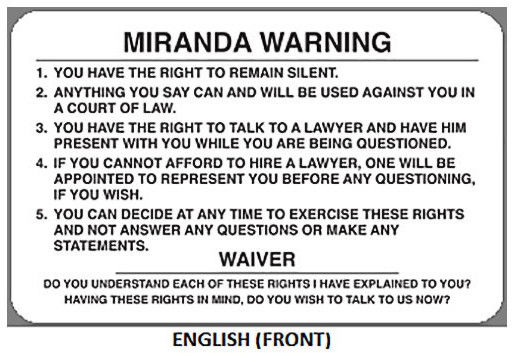
The Miranda v. Arizona case is among one of the most famous United States Supreme Court cases to date. Even without knowing any specific details about the case, most Americans recognize the infamous line: ‘You have the right to remain silent.’ Or they may recognize the term Miranda rights.
Miranda v. Arizona allowed for the nationwide practice in the United States of enforcing that detained people be properly Mirandized. Being Mirandized means that their Miranda rights are clearly stated and that the person being detained is made aware of their Fifth and Sixth Amendment rights.
Cornell Law states that the Fifth Amendment is: “In criminal cases, the Fifth Amendment guarantees the right to a grand jury, forbids “double jeopardy,” and protects against self-incrimination.” The vital part of the Fifth Amendment that was infringed in the Miranda v. Arizona case was the self incrimination portion. Miranda was not made aware of his rights protecting him against self incriminating. This led to Miranda signing off to a confession of a crime during his interrogation before being made aware of his rights, without an attorney present, and after possible psychological intimidation.
The Sixth Amendment is summarized by Cornell Law: “The Sixth Amendment guarantees the rights of criminal defendants, including the right to a public trial without unnecessary delay, the right to a lawyer…” The key component of the Sixth Amendment that was infringed in the Miranda v. Arizona case was the right to an attorney. As mentioned before briefly, Miranda confessed without an attorney present and without being made aware that he had the right to one. The purpose that these rights serve is to try to ensure a fair verdict at the end of the case, and without properly following the Fifth and Sixth Amendments this is not possible.
In 1963 Ernesto Miranda was arrested under pending kidnapping and rape charges. Miranda was interrogated by police for two hours where he confessed to the crimes and signed off to the confession. Miranda also signed off on being made aware of his Fifth and Sixth Amendment rights without actually being made aware of them. It is important to note that Miranda did not have an attorney present during this and Miranda suffered from a mental illness which could have an impact on the forced confession. Overall, this entire confession was deemed unfair and unethical to Miranda's attorney -Alvin Moore- who appealed the verdict of the lower court. The case was taken to the Arizona Supreme Court and the case was reaffirmed. When a case is reaffirmed by a higher court it means that the higher court is in agreement with the lower court's decision.
Miranda's case made its way to the United States Supreme Court -the highest court in the United States- which ruled that it was unconstitutional to use Miranda's confession against him because he was not made aware of his Fifth and Sixth Amendment rights. The use of a confession is acceptable if the detainee is read their Miranda rights and waives their right to an attorney.
After this ruling, Miranda was retried without the use of the confession and was sentenced to a maximum of thirty years in prison in comparison to the fifty-five year maximum he was convicted of the first time around.
The impact of this case led to the creation of the ‘Miranda Warning’ which can be seen in the photograph attached below. This warning covers some of the rights protected by the Fifth and Sixth Amendments and ensures that detainees are better aware of their rights while being detained.

By Elidia Magaña
Sources:



Comments